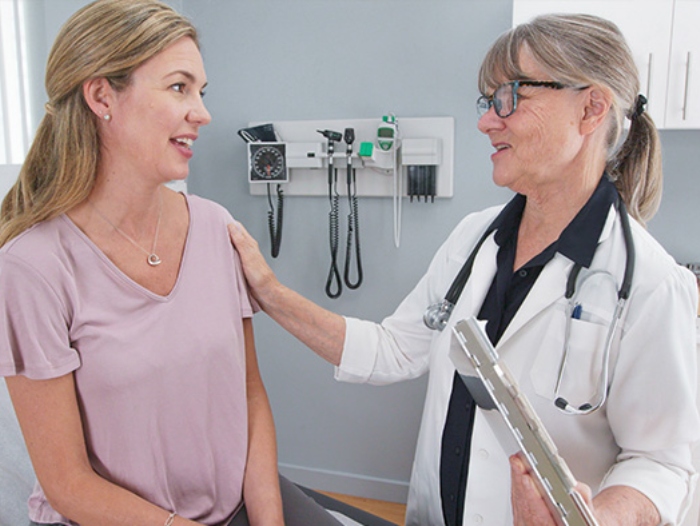Auto logout in seconds.
Continue Logout#1 ranked opportunity to improve women’s ob/gyn health1
There is an untapped opportunity for stakeholders across the industry to improve women’s menopause symptom care. With most women spending more than a third of their lives in peri- or post-menopause (perimenopause ranging between one and 14 years), many U.S. women would benefit from improved symptom care.2 We interviewed 16 healthcare leaders that shared opportunities for stakeholder groups to improve care for this condition with high chance of efficacy. And the opportunity to act isn’t limited to providers. Health plans, digital health companies, pharmaceutical companies, and policymakers can also effect change in their spheres of influence.
Evidence there is room for improvement
- 84% of midlife (age 40-65) U.S. women experienced symptoms and physical changes commonly associated with menopause, including vasomotor symptoms (hot flashes and night sweats), sleep disturbances, weight gain/slow metabolism, and reduced libido in 20223
- 46% of Black women on average experience vasomotor symptoms, compared to 37% of white women, according to a 25-year cohort study4
- 56% of midlife U.S. women experiencing menopause symptoms did not discuss treatment options with their provider in 20223
- 65% of midlife U.S. women said their healthcare provider did not talk to them about what to expect in menopause in 20225
- 7% of postgraduate residents in family medicine, internal medicine, and obstetrics and gynecology at U.S. residency programs reported feeling adequately prepared to manage women experiencing menopause in 20176
- 15% of large employers offered menopause benefits in 2023 or plan to in 20247
- $1.8 billion is lost annually in the form of lost work productivity related to menopause symptoms experienced by U.S. women aged 45 to 60 years8
Where is the industry falling short today?
The healthcare industry generally fails to enable women to effectively manage the menopause transition.8 Providers and health plans should educate women about peri- and post-menopause before they experience symptoms and physical changes. Providers should also engage women in shared decision-making on menopause treatment options such as hormone therapies, vaginal lubricants, and nonhormonal medications. Employers should offer women menopause-specific benefits and workplace flexibilities, including access to providers trained in menopause care and support groups.9 Employers should also cover a variety of menopause treatment options and allow temporary schedule adjustments and remote work options for those experiencing bothersome menopause-related symptoms.
Starting steps to enact change
No organization can solve women’s health inequities on its own. But every organization has a role to play in dismantling inequities in women’s care delivery. Below are some initial steps that organizations can take to improve menopause care for women.
Provider organizations
- Facilitate provider education on menopause management. Consider offering to pay exam fees for eligible clinicians on staff to attain the Menopause Society Certified Practitioner (MSCP) credential.10
- Encourage clinicians to diagnose menopause and educate patients on what to expect early. Engaging women in their 30s and 40s allows them to better understand common symptoms and physical changes that occur during their menopause transition and beyond.
- Adopt clinical decision support tools to improve adherence to clinical guidelines on menopause symptom management. UCLA and Mayo Clinic have developed decision support tools that use advanced algorithms to enable evidence-based menopause symptom management.11-12
Health plans
- Diversify offerings with menopause solutions. Menopause benefits are of growing interest to employers. Menopause solutions that cover therapies such as hormone therapy and nonhormonal medications (or remedies) can significantly improve quality of life and productivity for members experiencing symptoms.13-14
Digital health companies
- Create menopause solutions for health plans, providers, and employers. Solutions can include personalized menopause care, clinical decision support tools, and digital communities for people experiencing menopause symptoms.
Case example
Blue Cross Blue Shield of Michigan (2023)
- BCBSM provides health benefits to more than 4.7 million members residing in Michigan in addition to employees of Michigan-headquartered companies residing outside the state.
- BCBSM partnered with Maven Clinic to offer a digital care app to help members identify menopausal symptoms, explore treatment options, consult with experts, and connect with peers for communal support starting July 1, 2023.15
- Maven Clinic reports employers can expect between $1,200 to $2,100 in cost savings per member as a result of increased productivity associated with receiving their services.16
1 According to Advisory Board’s ranking of 10 ob/gyn conditions. 6 things to understand about women's health in the United States. Advisory Board. August 2023.
2 What Is Menopause? National Institute on Aging. Accessed October 15, 2024.
3 Morgan D. Women’s Health: Sex, Intimacy, and Menopause. U-M Institute for Healthcare Policy & Innovation. May 11, 2022.
4 Eldred SM. Black women suffer disproportionately from menopause symptoms. Awareness could help change that. Sahan Journal. April 27, 2023.
5 Long M, et al. Women’s Experiences with Provider Communication and Interactions in Health Care Settings: Findings from the 2022 KFF Women’s Health Survey. KFF. February 22, 2023.
6 Kling JM, et al. Menopause Management Knowledge in Postgraduate Family Medicine, Internal Medicine, and Obstetrics and Gynecology Residents: A Cross-Sectional Survey. Mayo Clinic Proceedings. February 2019.
7 Ewing C. and Leu C. Employers are taking meaningful steps to provide menopause benefits. Mercer. October 19, 2023.
8 Furst J. Mayo Clinic study puts price tag on cost of menopause symptoms for women in the workplace. Mayo Clinic. April 26, 2023.
9 5 ways employers can support women's health during midlife. Advisory Board. January 2024.
10 How to Earn an MSCP Credential. The Menopause Society. Accessed October 15, 2024.
11 Patil R. Comprehensive and Individualized Menopause Care Delivery Protocol With Technological Decision Support Aid (Case No. 2024-193). UCLA. Accessed October 15, 2024.
12 Ford T. Lisa Health launches Midday, an app leveraging AI to personalize the menopause journey, in collaboration with Mayo Clinic. Mayo Clinic. July 19, 2022.
13 Welton AJ et al. Health related quality of life after combined hormone replacement therapy: randomised controlled trial. BMJ. August 21, 2008.
14 Reed T. The growing menopause-at-work market. Axios. November 23 2022.
15 Blue Cross Blue Shield of Michigan offers new digital program for menopause as part of comprehensive Family Building and Women's Health Support Solution. PR Newswire. March 17, 2023.
16 Better outcomes, lower costs: how Maven Clinic is driving innovation. Maven Clinic. Accessed October 15, 2024.
Don't miss out on the latest Advisory Board insights
Create your free account to access 1 resource, including the latest research and webinars.
Want access without creating an account?
You have 1 free members-only resource remaining this month.
1 free members-only resources remaining
1 free members-only resources remaining
You've reached your limit of free insights
Become a member to access all of Advisory Board's resources, events, and experts
Never miss out on the latest innovative health care content tailored to you.
Benefits include:
You've reached your limit of free insights
Become a member to access all of Advisory Board's resources, events, and experts
Never miss out on the latest innovative health care content tailored to you.
Benefits include:
This content is available through your Curated Research partnership with Advisory Board. Click on ‘view this resource’ to read the full piece
Email ask@advisory.com to learn more
Click on ‘Become a Member’ to learn about the benefits of a Full-Access partnership with Advisory Board
Never miss out on the latest innovative health care content tailored to you.
Benefits Include:
This is for members only. Learn more.
Click on ‘Become a Member’ to learn about the benefits of a Full-Access partnership with Advisory Board
Never miss out on the latest innovative health care content tailored to you.





